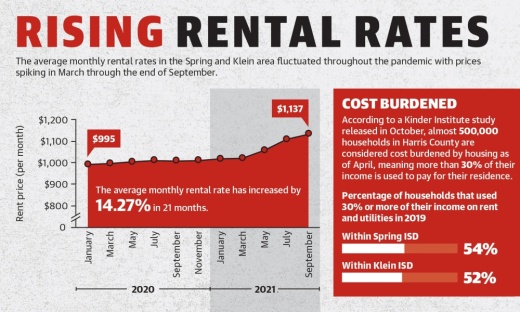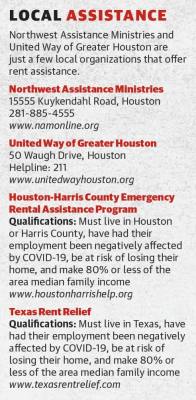In Harris County, 53% of residents worry whether they will be able to stay in their current homes due to the rising financial burden, according to a study by Rice University’s Kinder Institute of Urban Research released Oct. 19. Of families who are earning less than $50,000 annually with children, 18% have moved in the last three years due to rising housing costs, while 21% wanted to move but could not find affordable housing.
“We know that rents have gone up faster than wages, and people were struggling pre-pandemic,” said Leah Barton, director of strategic initiatives with the Office of Harris County Administration. “As people experienced loss of jobs—or in many cases even if they kept a job, loss of hours—and increase in expenses, ... they’ve really felt the squeeze.”
Almost 500,000 households in Harris County are considered “cost burdened” by housing, meaning more than 30% of their income is used to pay for their residence. As housing becomes a larger share of the budget for many families, Barton said some may be forced to cut back on other expenses such as health care or food.
New coronavirus cases and deaths in Texas have trended downward since early September, according to the Department of State Health Services. However, rent prices have risen to levels higher than they were pre-pandemic in the Spring and Klein area. Meanwhile, eviction moratoriums from the federal Coronavirus Aid, Relief and Economic Security Act and the Centers for Disease Control and Prevention ended this summer. Combined, these factors have boosted requests for rent assistance through local nonprofits.
Affordable housing needed
A lack of affordable housing in the Spring and Klein area is a problem that predates the pandemic and one that worsens every time an influx of people moves to the area, said Brian Carr, chief advancement officer for Northwest Assistance Ministries.
“[After] Hurricane [Katrina], we had a lot of refugees come over from Louisiana and move into this area,” Carr said. “We [had] a lot of displaced families after [Hurricane] Harvey move into the affordable housing here. Right now, we’re really seeing ... the aftereffects of this shortage of low-income and affordable housing up in this area.”
Meanwhile, the housing and rental markets have also been affected by the pandemic. The price of single-family homes has risen along with rental prices and occupancy.
“The supply for single-family homes has dropped and so that drives the price up,” ApartmentData.com President Bruce McClenny said. “Traditionally, there’s this movement from renters to be buyers of homes, and that has been disrupted in a big way.”
Data from the Texas A&M Real Estate Research Center shows home prices climbed and the amount of inventory plummeted over the pandemic in the Spring and Klein area. In two local market areas—Spring/Klein and the Champions area—median home sales prices rose 18% and 13.9%, respectively, from August 2019 to August 2021. In that same time period, the months of inventory—or the time it would take to sell all properties for sale at the average sales price—declined 75% and 65.5%, respectively, for both areas to about one month of inventory for each.
In terms of local rental trends, Spring-area rental and occupancy rates peaked in September, with an average rent price of more than $1,137 per month and an occupancy rate of 93%, McClenny said. By comparison, prior to the pandemic in October 2019, Greater Houston-area rental occupancy was at about 90% and monthly rental rates averaged $994.
Within Klein ISD’s boundaries, 73.6% of families owned the homes they occupied while 26.4% rented, according to 2019 U.S. Census Bureau estimates. For Spring ISD residents, renting families outweighed homeowners at 55% and 45%, respectively.
Facing eviction
Evictions are trending up again throughout Harris County. More than 1,400 cases were filed the week of Oct. 11, according to science consulting firm January Advisors, the highest weekly number since before the pandemic. One week later, about 1,339 evictions were filed.
Passed in March 2020, the CARES Act included an eviction moratorium through late July of last year. By September 2020, the CDC had issued its own national eviction moratorium, which officials hoped would slow the spread of COVID-19.
While evictions notably dropped in Harris County during the pandemic, moratoriums were not consistently enforced, according to January Advisors. Based on the firm’s data, more than 60,000 eviction filings have been made in Harris County, including about 6,500 in the Spring and Klein area, since the start of 2020.
Local complexes that have filed the most eviction cases include 136 filed by Toro Portfolio Investment and 130 at Serena Woods Apartments, according to January Advisors. These landlords did not respond to requests for comment as of press time.
After multiple extensions, the CDC’s moratorium ended late this summer. Data from Workforce Solutions shows the Houston region’s unemployment rate was about 6.1% at the time.
Right before and after the end of the eviction moratorium, Carr said NAM saw an uptick in families applying for rent assistance.
“We’re still seeing it,” he said. “It has created kind of a new urgency for a lot of these families to seek assistance and to get the rent assistance that they need.”
A report from January Advisors revealed the CDC’s moratorium delayed or prevented evictions for just 13% of defendants in Harris County.
Local resources
Renters needing assistance have a few options. The Houston-Harris County Emergency Rental Assistance Program had pledged or paid over $221 million to more than 57,000 families as of mid-October, most of which was subsidized by federal funds.
The program can cover up to18 months of rent as far back as April 2020, and up to two months can be allocated to current or future rent to allow tenants time to get back on their feet, officials said. Harris County renters whose employment has been affected by COVID-19, are at risk of losing their homes, and have household incomes at or below 80% of the area median family income can apply.
Prior to the pandemic, NAM was providing rental assistance to 10-15 families on a monthly basis; in early 2020, NAM was assisting about 150 families per month.
Since the start of the pandemic, the number of families NAM is helping on a monthly basis has dipped to about 80-90 receiving rent assistance and 30-40 receiving food assistance.
"We haven’t seen an increase over [early] pandemic numbers, but we also have not seen the decrease that we were expecting now that more people are going back to work and the pandemic is starting to have less of an impact on the economy,” Carr said. “So we are still seeing a pretty steady number of people applying for rent and food assistance.”
During the pandemic, United Way of Greater Houston has been focusing on helping residents who are considered Asset Limited, Income Constrained, Employed, or ALICE. According to United Way of Greater Houston, 41% of Spring-area residents and 47% of Greater Houston-area residents are considered ALICE or below.
United Way helps people in need find local resources including rent and mortgage assistance, child care, food stamps and domestic violence assistance through its 2-1-1 hotline.
“For solutions to be effective, they really must be comprehensive and interconnected to really address the multiple areas of struggle that a family or household might encounter,” said Jessica Davison, United Way of Greater Houston ALICE expert. “Finding avenues and resources for financial stability are so important.”
Sierra Rozen contributed to this report.









